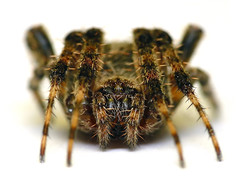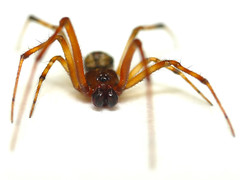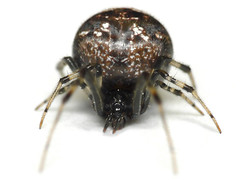For this genus of spiders, the web is a horizontal, sheet-like web, with a small funnel-like tube off to a side and a 3-dimensional barrier web over the top. When a flying insect hits the barrier, it falls into the sheet below. The funnel (or tube) is what the family (Agelenidae) is named for, and is used by the spider for hunting. The spider will lie in wait in the funnel, and when an insect flies hits the barrier and falls on the web, the spider will rush out, very quickly check to see if it is prey, and if it is prey, bite it. The venom is fast-acting on the prey, so once the prey is subdued the spider will drag the prey back into the funnel (for safety while eating, and to prevent other insects from recognizing the danger that lurks below on the web).
For Agelenopsis spp. spiders, the web is not sticky. If the insect lands/falls on the web, the web will actually become tangled around the prey's feet, temporarily ensnaring it in the web. The funnel web for Agelenopsis is a distinctive web, and often is noticed in bushes and grass, especially in the early fall mornings, where the dew has collected on the web. The webs can be expansive, covering several square feet, or just small webs in the grass.
Raynox DCR-250 mounted on my Panasonic Lumix FZ8.
mounted on my Panasonic Lumix FZ8.
For Agelenopsis spp. spiders, the web is not sticky. If the insect lands/falls on the web, the web will actually become tangled around the prey's feet, temporarily ensnaring it in the web. The funnel web for Agelenopsis is a distinctive web, and often is noticed in bushes and grass, especially in the early fall mornings, where the dew has collected on the web. The webs can be expansive, covering several square feet, or just small webs in the grass.
Raynox DCR-250



